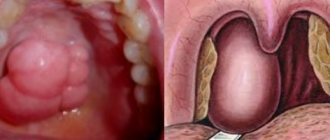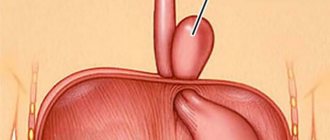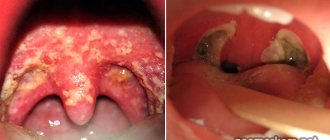Normally, the mucous membrane of the throat walls is smooth and has a uniform color. However, due to pathological changes occurring in the body, various rashes, including blisters, may appear on the surface of the larynx and in the oral cavity.
Depending on the type and degree of the disease, they can be filled with purulent or serous contents. Regardless of what bacteria and viruses caused the pathology, the patient must consult an otolaryngologist. Only he can find out the type of disease and draw up an effective treatment plan.
Why do blisters appear in the throat?
The main reason for the appearance of blisters is pathogenic microorganisms, which, when they enter the patient’s body, cause the development of pathologies. Due to the fact that the mucous membrane is often subject to trauma and is highly sensitive, the first signs of an incipient disease appear on it.
Angina
Follicular tonsillitis
The disease is characterized by the development of an inflammatory process as a result of an infectious infection in the oropharynx, often involving the velopharyngeal arch and soft palate. Not all types of tonsillitis are accompanied by the formation of blisters on the back of the throat. This is typical for enterovirus and herpetic etiology. Bacterial pathogens extremely rarely contribute to the development of such pathology.
A characteristic feature of tonsillitis is the rapid development of the clinical picture. Often, a person begins to experience intense symptoms just a few hours after infection.
Pathology is characterized by the appearance of:
- Intense pain syndrome. The pain reaches such a degree that the patient stops eating, drinking water and even speaking. The intensity decreases slightly immediately after drinking warm liquid, but quickly returns. Echoes of pain can be felt in the neck, spine and even in the face.
- Exudation. There is an intensive production of serous or purulent discharge.
- Severe itching and burning.
- High body temperature, up to febrile levels. Despite the nonspecificity of the symptom, its frequency is quite high.
- General intoxication. The patient experiences headaches, drowsiness, a feeling of general weakness, nausea and vomiting may develop.
- Blisters with purulent or bloody contents on the back of the throat.
Throat abscess
In the non-medical environment, an abscess is usually called an abscess; this name most accurately describes the essence of the disease.
Under the influence of an infectious lesion, tissue destruction occurs. The body's physiological response is to isolate the infected area. A fibrous capsule is formed, which prevents infection of the entire body. The pathology is always infectious in nature; the most common culprits are streptococci, adenoviruses, staphylococci, rotaviruses and enteroviruses. The pathology is characterized by:
- Visual identification of a convex lesion with white or red contents on the back of the throat. The size can vary from a few millimeters to three centimeters. The larger the diameter, the more dangerous the process.
- Intense pain. The pain is burning, aching and stabbing in nature. Sensations radiate to all surrounding tissues.
- Increasing temperature.
- A change in the relief of the back surface of the throat to be granular and unevenly colored.
Pharyngitis
Granular pharyngitis is often characterized by the appearance of red blisters on the laryngeal mucosa.
The pathology may be infectious-inflammatory or allergic in nature. The pathology is very widespread. The disease is characterized by the appearance of:
- Pronounced pain syndrome. The pain is nagging, burning in nature. Eating food only increases the discomfort; it can radiate to the neck and directly to the pharynx.
- Sensation of a foreign body in the throat. Severe swelling of the pharyngeal tissues and a serious inflammatory process cause problems in almost all cases.
- Voice problems. Swelling of the vocal cords leads to the disappearance of the voice, complete or partial.
- Sore throat.
- Unproductive stool.
- High temperature.
- Symptoms of intoxication throughout the body.
Chickenpox (internal form)
Chickenpox is an infectious dermatological disease of viral etiology. It occurs as a result of damage to the body by the herpes virus Varicella-Zoster. In most cases, children of primary school age suffer from the disease, but infection is possible even in adulthood if immunity was not developed in childhood.
Without proper treatment, the viral infection spreads to the entire body, affecting all structures and internal organs. Consequently, the mucous membrane is also affected.
Chickenpox is characterized by:
- The appearance of small papules of a transparent or slightly reddish hue. If the disease is treated appropriately, the blisters open and heal.
- Ulceration of lesions after scratching. If the pathology is not diagnosed in time and it spreads to the oral cavity, then the symptoms will be similar to stomatitis.
- Severe itching and burning.
- Redness of the throat and the appearance of a small papular rash of a white or red hue.
- An increase in body temperature to pyretic values. This can be extremely dangerous and such intense heat should be brought down immediately.
Stomatitis
Stomatitis
This disease is an inflammatory lesion of the oral mucosa. In most cases, infection occurs on the tongue, lips, cheeks and throat mucosa. In the absence of appropriate therapy, the process develops rapidly. The disease can be of herpetic, aphthous and necrotic types. The cause of the disease is infection.
The pathology is characterized by:
- The appearance of burning pain in the oral cavity. After further spread of the infection into the pharynx, the location of the pain syndrome changes.
- Feeling of severe itching in the throat.
- Formation of white blisters on the back of the throat. Serous type exudate and opening of papules occurs spontaneously. The rash is limited to just a few blisters, no more than eight.
- General intoxication.
- Increased temperature in severe forms of the disease.
Herpangina
Herpangina is a serious airborne infection, which is why it has the ability to quickly spread among people interacting with each other. Bacteria, entering the blood vessels, ultimately end up in the lymph of the oral cavity, where inflammation begins. Almost the same pimples form in the larynx as with follicular sore throat, only with a whitish filler. Then these bubbles on the throat burst and the liquid contained there flows out. These outgrowths are called vesicles, which quickly infect the mucous membrane, clustering and capturing the following places.
Other symptoms include:
- rapid development of infection;
- extremely high temperature;
- severe runny nose (rhinitis);
- intoxication (lethargy, body aches, abdominal pain, nausea and, as a result, loss of appetite);
- swelling of the tonsils and palate;
- a sore throat;
- copious amounts of saliva;
- scabies;
- problems swallowing (severe pain);
- enlarged lymph nodes.
It is interesting that blisters with a pus-like fluid appear in one place, while in another they burst and gradually form scars; the disease recedes.
Most people get this disease through contact with its carrier, although there are rare cases where the infection was transmitted from animals. Streptococcus and staphylococcus may also be to blame. Bacteria are transmitted through the air, through feces, animals and contact with people.
After the diagnosis is made, the patient is prescribed a whole range of drugs: antihistamines, antibiotics, antipyretics, antiseptics, antivirals. You need to keep the same bed rest, not eat potentially harmful food and forget about alcohol.
You need to gargle with herbal decoctions, drink propolis tincture, moisten your throat with beet juice and generally drink more if you want to get rid of red blisters on your throat, photos of which can be seen in the article, in order to recharge your motivation.
Diagnostics: what needs to be examined?
An otolaryngologist can carry out a diagnosis, establishing a diagnosis after a thorough examination and carrying out all the necessary tests.
To identify pathology it is necessary to:
- visual assessment of the pharynx using a spatula and a mirror;
- taking anamnesis;
- taking a test for general blood diagnostics, which will reveal the presence of allergens or an inflammatory process;
- diagnostics to determine the type of virus, as well as its activity in the body;
- analysis to determine the stage of infection;
- collection of biomaterial for serological testing, as well as bacteriological culture.
Usually, the above studies are sufficient to determine the type of disease and develop an appropriate treatment regimen. However, in some cases, additional consultation with a specialized specialist may be required.
How to get rid
Depending on the type of rash, treatment measures will vary. Only a specialist can draw up a treatment regimen. However, there are general rules for treating rashes depending on their appearance.
White formations
Blisters with white contents are most often the result of an infectious lesion.
Their therapy is complex. The disease requires taking:
- antibiotics - to get rid of the bacterial component;
- prebiotics - to establish the normal functioning of the digestive tract;
- antiviral agents - to destroy the viral component;
- antihistamines - to reduce swelling and relieve the inflammatory process;
- anti-inflammatory drugs;
- immunomodulators;
- painkillers.
In order to disinfect the surface of the mucous membrane when papules tend to rupture, the doctor prescribes an antiseptic drug. This avoids the connection of additional infections to the open wound.
Additionally stimulate recovery:
- Drink plenty of fluids - a variety of drinks are suitable, ranging from plain water to vitamin drinks with ascorbic acid.
- Supplementing your diet with multivitamins.
- Inhalations based on plant components (herbs or propolis). To prepare the solution, add a tablespoon of propolis to a liter of boiling water. You need to spend up to fifteen minutes above the steam.
- Gargling with a solution based on propolis tincture.
- Applying a fresh cabbage leaf to the throat area. The compress is replaced every two hours.
Red formations
Red formations are always a consequence of stomatitis and require mandatory treatment with medications. The complex therapy includes antiviral drugs for internal use and for local use, immunomodulators and gels with an anesthetic effect.
It is strictly prohibited:
- Warm up the throat area - high temperature will only intensify the inflammatory process and aggravate the situation with suppuration.
- Removing pustular formations yourself will lead to the spread of the process throughout the body.
- Disinfect ulcerations that have arisen at the site of ruptured papules using alcohol-containing products. This can cause burns to the mucous membrane and increased swelling.
Prevention
There is no universal preventative against the formation of blisters on the throat. This is due to the fact that the formation of papules can be symptoms of a large number of diseases that are in no way related to each other. However, following certain measures can significantly reduce the risk of developing many pathologies associated with sore throat.
Preventive measures:
- Strengthening the immune system plays a key role in resisting various types of infections. A weakened immune defense is not able to effectively cope with pathological pathogens and, as a result, the patient becomes infected.
- Refusal of food that is too hot or too cold (including drink). Taking food and liquid at inappropriate temperatures can lead to trauma to the mucous membrane and the entry of infectious agents into the wound surface.
- Maintaining hygiene. It’s not worth talking about the fact that stomatitis is a disease of dirty hands. It is necessary to carefully monitor the cleanliness of your hands before starting to eat. It is also important to maintain oral hygiene using a toothbrush and special floss at least twice a day.
- Treat carious teeth in a timely manner. The presence of a focus of a chronic infectious process in the oral cavity is a time bomb. Any weakening of the immune system can lead to the development of a more serious pathology.
- Lead a healthy lifestyle. Smoking leads to thinning of the mucous membrane and its dryness. This is fraught with a greater tendency to form chronic inflammatory processes in the larynx and oral cavity.
Bacterial pharyngitis
This disease is dangerous because if symptoms are ignored for a long time or due to inadequate treatment, the likelihood of the disease becoming chronic increases. It is quite easy to become infected with the disease, because the main routes of infection are contact with sick people and frequent hypothermia.
The first stage of symptoms is accompanied by pain when swallowing, soreness and dryness. Patients complain of a sensation of bubbles in the throat or the presence of a foreign body, as well as signs of fever and general weakness.
The next stage is an increase in the submandibular and occipital lymph nodes, the appearance of painful sensations in the ears and severe headaches. The temperature rarely exceeds 38 degrees, but most often it is in an elevated state.
An article on the topic - how to cure a throat in a day.
What is pharyngitis










